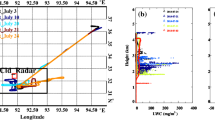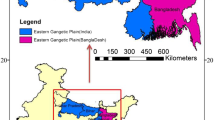Abstract
Based on the precipitable water observations easily available from in situ and remote sensing sensors, a simple approach to define the lifting condensation level (LCL) is proposed in this study. High-resolution radiosonde and microwave radiometer observations over peninsular Indian region during the Cloud Aerosol Interaction and Precipitation Enhancement Experiment Integrated Ground Observational Campaign (CAIPEEX-IGOC) during the monsoon season of 2011 are used to illustrate the unique relationship. The inferences illustrate a linear relationship between the precipitable water (PW) and the LCL temperature. This relationship is especially valuable because PW is easily available as a derived parameter from various remote sensing and ground-based observations. Thus, it could be used to estimate the LCL height and perhaps also the boundary layer height. LCL height and PW correlations are established from historical radiosonde data (1984–2012). This finding could be used to illustrate the boundary layer-cloud interactions during the monsoon and is important for parameterization of boundary layer clouds in numerical models. The relationships are illustrated to be robust and seem promising to get reasonable estimates of the LCL height over other locations as well using satellite observations of PW.







Similar content being viewed by others
References
Betts AK (2000) Idealized model for equilibrium boundary layer over land. J Hydrometeorol 1:507–523. doi:10.1175/1525-7541(2000)001<0507:IMFEBL>2.0.CO;2 (AMS 15th Hydrology Conf., Long Beach, CA.)
Betts AK (2004) Understanding hydrometeorolgy using global models. Bull Am Meteorol Soc 85:1673–1688. doi:10.1175/BAMS-85-11-1673, American Meteorological Society Robert E. Horton Lecture, January 14, 2004, Seattle.Bolton, D., 1980: The computation of equivalent potential temperature. Mon. Wea. Rev.,108, 1046–1053
Betts RA, Cox PM, Collins M, Harris PP, Huntingford C, Jones CD (2004) The role of ecosystem-atmosphere interactions in simulated Amazonian precipitation decrease and forest dieback under global climate warming. Theor Appl Climatol 78:157–175. doi:10.1007/s00704-004-0050-y
Deardorff JW, Willis GE, Stockton BH (1980) Laboratory studies of the entrainment zone of a convectively mixed layer. J Fluid Mech 100:41–64. doi:10.1017/S0022112080001000
Gadgil S, Joseph PV (2003) On breaks of the Indian monsoon. Proc Indian Acad Sci 112:529–558
Lawrence M (2005) The relationship between relative humidity and the dewpoint temperature in moist air—a simple conversion and applications. Bull Am Meteorol Soc 86:225–233. doi:10.1175/BAMS-86-2-225, 20, 2005. 29367, 29375, 29376
Li JLF, Mechoso CR, Arakawa A (1999) Improved PBL moist processes with the UCLA GCM. In Proceedings of the 10th Symposium on Global Change Studies, American Meteorological Society, Dallas, pp 423–426, 10–15 January 1999
Li X, Sui C-H, Lau K-M (2002a) Interaction between tropical convection and its embedding environment: an energetics analysis of a 2D cloud resolving simulation. J Atmos Sci 59:1712–1722. doi:10.1175/1520-0469(2002)059<1712:IBTCAI>2.0.CO;2
Li X, Sui C-H, Lau K-M (2002b) Precipitation efficiency in the tropical deep convective regime: a 2-D cloud resolving modeling study. J Meteor Soc Japan 80:205–212. doi:10.2151/jmsj.80.205
Li X, Sui C-H, Lau K-M (2002c) Dominant cloud microphysical processes in a tropical oceanic convective system: a 2D cloud resolving modeling study. Mon Weather Rev 130:2481–2491. doi:10.1175/1520-0493(2002)130<2481:DCMPIA>2.0.CO;2
Mahrt L (1979) Penetrative convection at the top of a growing boundary layer. Q J R Meteorol Soc 105:469–485. doi:10.1002/qj.49710544411
Manton MJ (1982) A model of fair-weather cumulus convection. Bound-Lay Meteorol 22:91–107
Mears C, Wang J, Ho S-P, Zhang L, Zhou X (2012) Total column water vapor. Bull Am Meteorol Soc 93(7):S44–S45
Murray FW (1967) Atmospheric transparency at 225 GHz over Chajnantor, Mauna Kea, and the South Pole. J Appl Meteorol 6:203
Rangarajan S, Mani A (1982) Total precipitable water in the atmosphere over Indian region. Proc Indiana Acad Sci (Earth Planet Sci) 91:189–207
Sherwood SC (1999) Convective precursors and predictability in the tropical western Pacific. Mon Weather Rev 127:2977–2991. doi:10.1175/1520-0493(1999)127<2977:CPAPIT>2.0.CO;2
Stephens GL (1990) On the relationship between water vapour over the oceans and sea surface temperature. J Clim 3:634–645
Stull RB (1984) Transilient turbulence theory. Part I: the concept of eddy mixing across finite distances. J Atmos Sci 41:3351–3367. doi:10.1175/1520-0469(1984)041<3351:TTTPIT>2.0.CO;2
Tompkins AM (2001a) Organization of tropical convection in low vertical wind shears: The role of water vapor. J Atmos Sci 58:529–545. doi:10.1175/1520-0469(2001)058<0529:OOTCIL>2.0.CO;2
Tompkins AM (2001b) Organization of tropical convection in low vertical wind shears: The role of cold pools. J Atmos Sci 58:1650–1672. doi:10.1175/1520-0469(2001)058<1650:OOTCIL>2.0.CO;2
Trenberth KE, Stepaniak DP (2003) Seamless poleward atmospheric energy transports and implications for the Hadley circulation. J Clim 16:3706–3722
Ware R, Cimini D, Campos E, Giuliani G, Albers S, Nelson M, Koch SE, Joe P, Cober S (2013) Thermodynamic and liquid profiling during the 2010 Winter Olympics. Atmos Res 132–133:278–290
Wilde NP, Stull RB, Eloranta EW (1985) The LCL zone and cumulus onset. J Clim & Appli Meteo 24:640–656
Zhu P, Zhao W (2008) Parameterization of continental bounday layer clouds. J Geophys Res 113. doi:10.1029/2007/JD009315
Acknowledgments
The Indian Institute of Tropical Meteorology (IITM) and the CAIPEEX experiment are fully funded by the Ministry of Earth Sciences (MOES), Government of India, New Delhi. N. Malap would like to acknowledge the support from MoES to SP University of Pune through the CTCZ project to Dr. Anand Karipot.
Author information
Authors and Affiliations
Corresponding author
Rights and permissions
About this article
Cite this article
Murugavel, P., Malap, N., Balaji, B. et al. Precipitable water as a predictor of LCL height. Theor Appl Climatol 130, 467–476 (2017). https://doi.org/10.1007/s00704-016-1872-0
Received:
Accepted:
Published:
Issue Date:
DOI: https://doi.org/10.1007/s00704-016-1872-0




